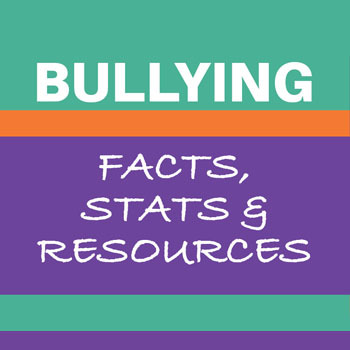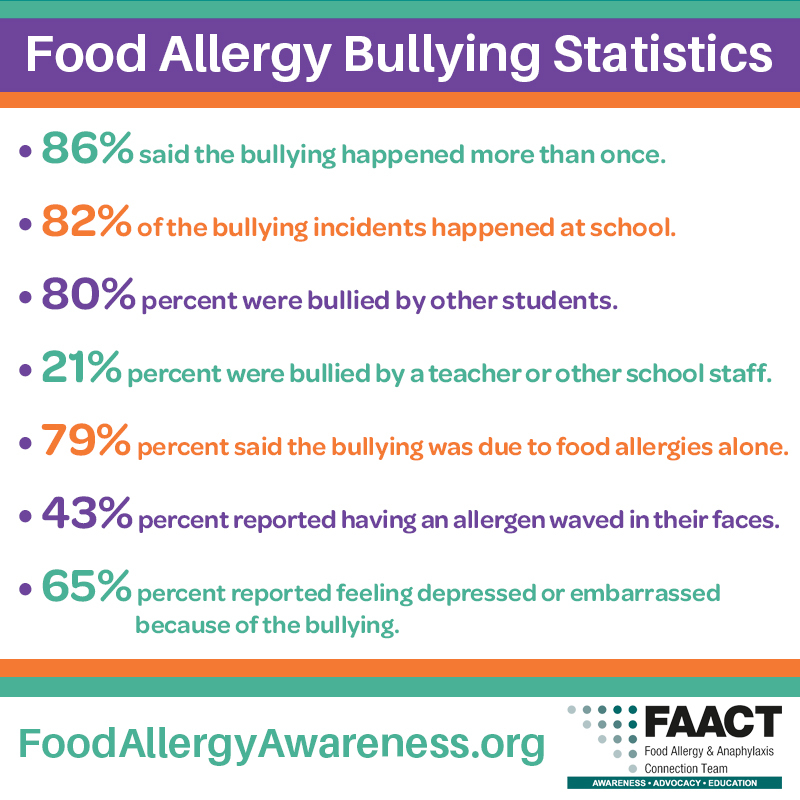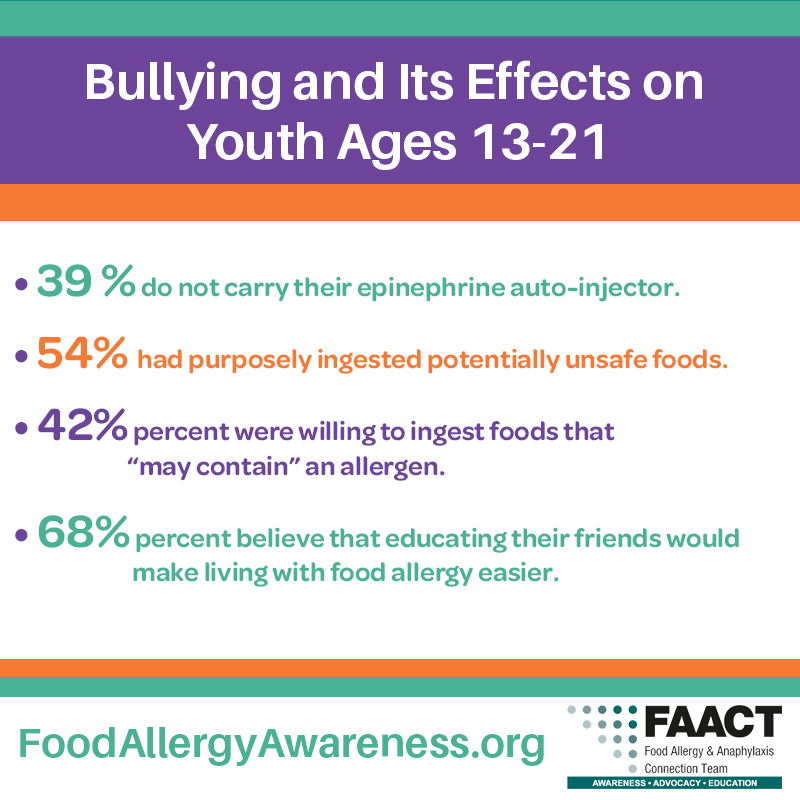Bullying Facts, Stats & Resources
Subcategories

Facts about Bullying
Bullying a student with food allergies is considered a form of disability harassment. Some incidents may meet the criteria for lawful consequence. Following are rare but serious examples of peer-to-peer bullying that resulted in such consequences:

Bullying and its Effects on Children
A 2010 study by doctors at Mount Sinai Medical Center[2] found that among children older than five who have food allergies, 35 percent experienced bullying, teasing, or harassment due to food allergies. Of those children,
- 86 percent said the bullying happened more than once.
- 82 percent of the bullying incidents happened at school.
- 80 percent were bullied by other students.
- 21 percent were bullied by a teacher or other school staff.
- 79 percent said the bullying was due to food allergies alone. Others reported bullying related to other issues, including carrying medication, being set apart at lunch, and getting “special treatment.”
- 43 percent reported having an allergen waved in their faces.
- 65 percent reported feeling depressed or embarrassed because of the bullying.
The study concluded that “Bullying, teasing, and harassment of children with food allergy seems to be common, frequent, and repetitive. These actions pose emotional and physical risks that should be addressed in food allergy management.”

Risk-Taking and Coping Behaviors
Bullying has also been shown to increase risky behavior among children with food allergies. A study[3] of food-allergic youth ages 13 to 21 found that:
- 39 percent do not carry their epinephrine auto-injector.
- 54 percent had purposely ingested potentially unsafe foods.
- 42 percent were willing to ingest foods that “may contain” an allergen.
- 68 percent believe that educating their friends would make living with food allergy easier.
Risk-taking behavior varied greatly depending on the social circumstances and perceived risks – possibly based on attempts to “fit in” with their peers. Researchers noted that “teens reported feeling different and less concerned about ingesting an allergen and have more recent reactions. The significance in this statement is that teens will eat products that may contain their allergens and/or have cross contamination label warnings. Medical professionals are concerned about this risk as they result in more recent reactions. These attempts by teens appear as an attempt for inclusion and fitting in peer social situations.” The research indicates that educating teens and their peers might reduce risk taking and its consequences.
Bullying Intervention in School
Assistant professor of criminology and criminal justice at the University of Texas–Arlington, Seokjin Jeong, led a study on bullying. He found that schools that implemented anti-bullying programs were only marginally effective. Students attending schools with anti-bullying programs were actually more likely to be bullied. “The schools with interventions say, ‘You shouldn’t do this,’ or ‘You shouldn’t do that.’ But through the programs, the students become highly exposed to what a bully is and they know what to do or say when questioned by parents or teachers,” Jeong said. The study noted that improvements in the school climate resulted in decreased bullying victimization and antisocial behavior. “Security measures . . . and teachers’ awareness of anti-bullying policies and strategies can intervene to reduce peer victimization. Schools in which teachers are aware of school policies on bullying victimization tend to have fewer incidents of bullying victimizations.”
According to Stuart Twemlow, a visiting professor of health sciences at University College, London, “Targeting bullies is a great way to fail at stopping bullying.” A more effective way of reducing the bullying incidents is by improving the school climate, Twemlow explains. “Bullies are not the problem. Bullies are the result of the problem. And when you have a lot of bullies at a school, you have a problem with the leadership of the school. And that's complicated."
Impact of Inclusion in Schools to Reduce Bullying
Schools play an important role in a food-allergic student’s educational life – not just academically or in the health needs of the student but in ensuring that the food-allergic student is included in programs and activities provided by the school. In doing so, this helps reduce the risk of bullying incidents. For some educators, managing food allergies in the educational setting can seem daunting. The following list may help provide guidance for inclusion:
- Provide a safe environment by reducing the risk of exposure to the allergen in the classroom, whether that’s providing an allergen-free or food-free classroom according to the food-allergic student’s IHCP/Section 504 plan.
- Refrain from exposing the student’s medical privacy or labeling the student (“allergy kid”or “peanut boy/girl” or asking in front of all students, “Who here has the food allergy?”).
- Refrain from segregating students with food allergies to a separate area during activities. For example, having a student sit outside in the hallway or send the student to the library while performing an activity in the classroom “for the student’s safety.” A more acceptable way of safely performing the activity to include the student is to adhere to the student’s IHCP/Section 504 plan and/or refrain from using the student’s allergen in the classroom. Inclusion of students is important for all students to reduce bullying incidents.
- Participate in food allergy awareness campaigns. For example, Food Allergy Awareness Week.
- Improve the school culture and climate for both staff and students.
- Provide a Positive Behavioral Intervention and Supports program or similar program to promote and focus on positive behaviors (see resource below for link).
- If bullying occurred, it may be appropriate to maintain the food allergic student’s safe environment by not changing their schedule in order to provide comfort and familiarity. This is especially important so that the student has knowledge of trained staff who he/she is comfortable with going to for help.
Providing staff with inclusive practices for an improved school culture can reduce bullying incidents. If peers and staff are not educated on food allergies and schools do not provide a more inclusive environment, especially starting at the elementary level, it can contribute to the rise of bullying incidents. When food allergic students enter middle and high school, the bullying incidents can follow them and increase. This can result in emotional distress and anxiety, which is a barrier to learning.
FAACT:
Each year, an estimated 160,000 students miss school due to the fear of being bullied.

Resources
- Food Allergy Bullying Article with FAACT CEO, Eleanor Garrow-Holding, and Living Without Magazine, January 2013
- Framing Bullying for Educators
- Bullying - What Is Food Allergy Bullying?
- Bullying - Keys to Standing Up, Involvement, & Inclusion
Additional Resources
- Cyberbullying Research Center - Resources for Educators
- Cyberbullying in College
- Inclusive Schools
- Positive Behavioral Interventions and Support (PBIS)
- StopBullying.gov
- The Bully Project - Educators
- The Bully Project - Special Needs for Educators
References
[1] U.S. Department of Health and Human Services, StopBullying.gov (http://www.stopbullying.gov/what-is-bullying/definition/index.html), accessed December 2013.
[2] Sicherer, Scott et al. “Bullying among pediatric patients with food allergy.” Annals of Allergy, Asthma & Immunology, Vol 105, Issue 4 (October 2010).
[3] “Risk-taking and coping strategies of adolescents and young adults with food allergy.” Journal of Allergy and Clinical Immunology. 2006 Jun;117(6).

